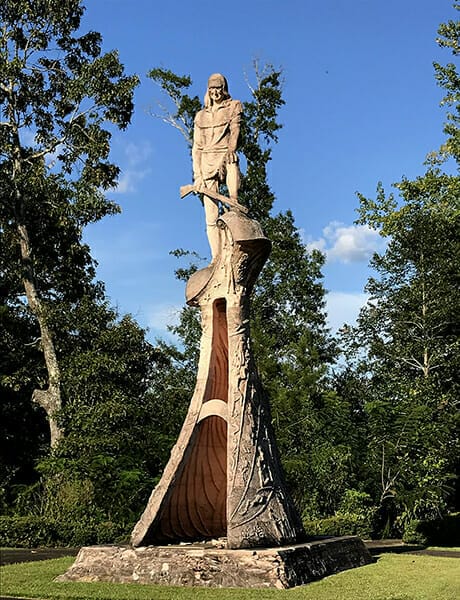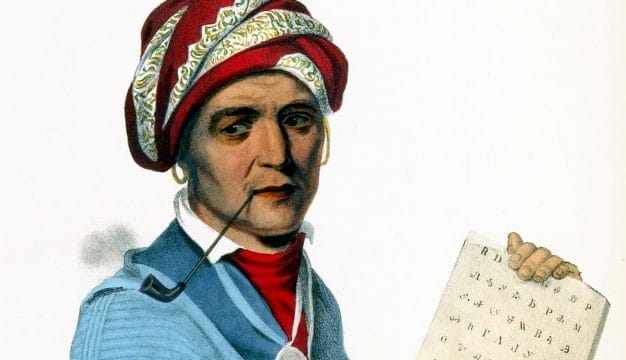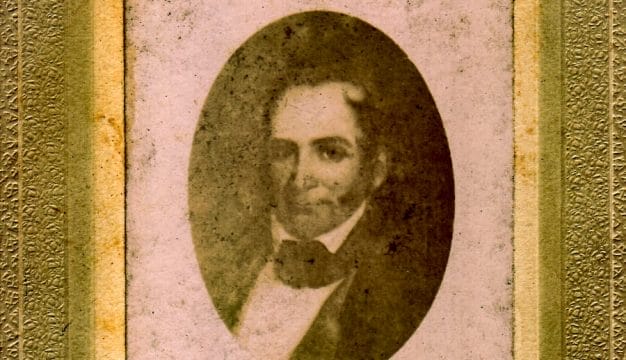Samuel Dale
Samuel Dale (1772-1841) was a scout, frontiersmen, soldier, and public servant who played an important role in carving the state of Alabama out of the Mississippi Territory. His frontier exploits, particularly those involving his participation in the Creek War of 1813-14, earned him hero status among early Alabamians and the nickname the “Daniel Boone of Alabama.”
 Samuel Dale
Dale was born in 1772 in Rockbridge County, Virginia, where his Scots-Irish parents Samuel and Mary O’Brian Dale had recently moved from Pennsylvania. The family’s early years were spent moving southwest with the frontier, before they finally settled on a farm in Greensborough, Georgia, in 1783. Both of Dale’s parents died in 1792, leaving him, at the age of 20, in charge of his seven orphaned brothers and sisters. He was able to support his family despite incessant raids by Creek Indians and in 1793 joined a cavalry troop fighting the raiding Creeks. After the troop disbanded in 1796, Dale went to Savannah, Georgia, where he established a wagoning business engaged in the transportation of goods. He operated this business in the winter and returned to his farm in the spring to help his brothers with planting.
Samuel Dale
Dale was born in 1772 in Rockbridge County, Virginia, where his Scots-Irish parents Samuel and Mary O’Brian Dale had recently moved from Pennsylvania. The family’s early years were spent moving southwest with the frontier, before they finally settled on a farm in Greensborough, Georgia, in 1783. Both of Dale’s parents died in 1792, leaving him, at the age of 20, in charge of his seven orphaned brothers and sisters. He was able to support his family despite incessant raids by Creek Indians and in 1793 joined a cavalry troop fighting the raiding Creeks. After the troop disbanded in 1796, Dale went to Savannah, Georgia, where he established a wagoning business engaged in the transportation of goods. He operated this business in the winter and returned to his farm in the spring to help his brothers with planting.
The business prospered enough that Dale could invest in a trip to trade among the Creeks in 1799. Soon thereafter, in response to the increasing migration of settlers from Georgia and the Carolinas into the Mississippi Territory, Dale contracted to bring families into the territory by wagon and then return to Savannah with Indian trade goods. Because of his experience in trade with the Indians of the region, in 1803 Dale was appointed as a guide for federal forces mapping a road through the Cherokee nation in northwest Georgia. In 1811, Dale accompanied U.S. Indian agent Benjamin Hawkins to the annual grand council of the Creeks at Tuckabatchee on the Tallapoosa River in present-day Elmore County. While there, he witnessed Shawnee chieftain Tecumseh’s famous speech to the assembled Creeks urging them to join a pan-Indian confederation and resist white expansion.
In July 1813, Dale was wounded in the first engagement of the Creek War during theBattle of Burnt Corn Creek when his militia unit ambushed Creek warriors returning from Pensacola, then in Spanish West Florida, where they had purchased gunpowder and supplies from the Spanish. After the battle, Dale went to Fort Madison in Clarke County to recuperate and to help defend the women and children there seeking protection from Creek war parties. On November 12, 1813, Dale was involved in a storied skirmish of the Creek War, known simply as the “Canoe Fight.” On a reconnaissance mission, Dale, Jeremiah Austill, James Smith, and a free black man named Caesar were separated from their main force when they came upon a party of Creeks paddling down the Alabama River in present-day Monroe County. Dale’s party, although outnumbered, killed all of the Indians remaining in the canoe to the cheers of their fellow militiamen viewing the action from the opposite bank of the river.
Just a few weeks after this encounter, Dale accompanied General Ferdinand Claiborne‘s federal troops to attack a large number of Creeks who had gathered at Econochaca, or the “Holy Ground,” located on the Alabama River in present-day Lowndes County. During this engagement, Dale witnessed William Weatherford escape capture by leaping with his horse into the river from atop a 15-foot bluff. Like the Canoe Fight, Weatherford’s escape and Dale’s participation in these events achieved mythic status among Alabamians.
After the Creek War, Dale farmed for awhile near Fort Claiborne, Monroe County. In late December 1814, Dale was dispatched to delivered a message to General Jackson and arrived just as the Battle of New Orleans was commencing on January 8, 1815, and was reportedly awestruck by the spectacle of open field warfare. Dale returned to an area now known as Dale’s Ferry on the Alabama River in Monroe County to engage in merchandising and farming.
 Samuel Dale Monument
Much of the rest of Dale’s life was devoted to public service. Soon after the War of 1812, he was elected a delegate at a convention seeking a division of the Mississippi Territory. While serving in the territorial legislature in 1817, Gov. William Wyatt Bibb commissioned Dale as a colonel in the Alabama militia. He later became a member of the first General Assembly of the Alabama Territory and served in the state’s legislature from 1819 to 1820 and again from 1824 to 1828. In 1821, he was appointed a commissioner to establish a public road from Tuscaloosa to Pensacola and then on to Blakeley in Baldwin County and Fort Claiborne. The Alabama legislature later bestowed upon him the rank of brigadier general and a lifetime pension for his service. In 1831, Dale was appointed to help remove the Choctaw Indians to their treaty-mandated territory on the Arkansas and Red rivers but was unable to make the journey because of severe injuries he sustained when his horse fell early in the trip.
Samuel Dale Monument
Much of the rest of Dale’s life was devoted to public service. Soon after the War of 1812, he was elected a delegate at a convention seeking a division of the Mississippi Territory. While serving in the territorial legislature in 1817, Gov. William Wyatt Bibb commissioned Dale as a colonel in the Alabama militia. He later became a member of the first General Assembly of the Alabama Territory and served in the state’s legislature from 1819 to 1820 and again from 1824 to 1828. In 1821, he was appointed a commissioner to establish a public road from Tuscaloosa to Pensacola and then on to Blakeley in Baldwin County and Fort Claiborne. The Alabama legislature later bestowed upon him the rank of brigadier general and a lifetime pension for his service. In 1831, Dale was appointed to help remove the Choctaw Indians to their treaty-mandated territory on the Arkansas and Red rivers but was unable to make the journey because of severe injuries he sustained when his horse fell early in the trip.
Dale spent most of his remaining years in Lauderdale County, Mississippi, where he became that county’s first representative in the Mississippi legislature in 1836. He travelled to the nation’s capital, where he visited with President Andrew Jackson and other leading political figures of the time, including John C. Calhoun, Henry Clay, Daniel Webster, and Thomas Benton. Samuel Dale died on May 24, 1841, and was buried near Daleville, Lauderdale County, Mississippi, which was named for him. There is no evidence that Dale ever married or had any children. In Alabama, Dale County is likewise named in his honor.
Additional Resources
Claiborne, J. F. H. The Life and Times of Gen. Sam Dale. New York: Harper & Brothers Publishers, 1860.
DuBose, John Campbell. Sketches of Alabama History. Philadelphia: Eldredge & Brother, 1901.



